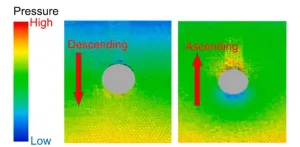(Press-News.org) A study uses body-worn camera footage as a source of data on police-community interactions. Nicholas Camp and colleagues analyzed transcripts from 615 police stops made in California by Oakland Police Department police officers before and after a procedural justice training, which focused on officer communication in routine traffic stops. The training included findings by the authors in a previous study that showed officers used more respectful language with White drivers than with Black drivers during traffic stops. The training recommended that officers 1) begin a stop by greeting the driver and introducing themselves; 2) explicitly state the legal justification for the stop early in the encounter; 3) express concern for the driver’s safety; 4) reassure the driver; and 5) use formal titles when addressing the driver. Using a combination of automatic detection and trained coders, the authors found that the training led to a statistically significant increase in the number of these communication techniques used. Post-training stops were twice as likely to use all five techniques than pre-training stops. Trends were broadly similar across all races of drivers. According to the authors, the study serves as an example of how body camera footage can be used as a source of data to study and evaluate changes in policing behaviors.
END
Police body-camera footage as data
2024-09-17
ELSE PRESS RELEASES FROM THIS DATE:
Intimate partner violence: Preserving patient privacy saves lives
2024-09-17
Historically, South Carolina has had some of the highest rates of intimate partner violence, or IPV, in the U.S. IPV encompasses any physical or sexual violence, stalking and psychological aggression by a current or previous partner or spouse.
“There is an epidemic of intimate partner violence in South Carolina,” said Leslie A. Lenert, M.D., associate provost of Data Science and Informatics and director of the Biomedical Informatics Center at the Medical University of South Carolina.
To address that epidemic, Lenert partnered with clinical psychologist Alyssa A. Rheingold, Ph.D., family physician Vanessa Diaz, M.D., and health services ...
Moving particle simulation-aided soil plasticity analysis for earth pressure balance shield tunnelling
2024-09-17
Infrastructures often suffer severe damage due to geotechnical hazards of both natural kinds such as floods or earthquakes and man-made ones like underground construction work and excavations. The fields of civil engineering and disaster risk management have extensively studied methods to prevent these risks and are still looking for more effective ways of avoiding large-scale deformations associated with said hazards. The advent of computer-aided simulations has provided researchers with particle-based methods such as moving particle ...
Identifying body-scan postures suitable for people with hyperactivity tendency
2024-09-17
ADHD is a developmental condition of brain with symptoms such as inattention, hyperactivity or impulsivity. People with ADHD lack the ability of self-control and experience anxiety, depression, academic failure, and low self-confidence. These symptoms can be alleviated by a holistic approach such as mindfulness-based stress reduction and mindfulness-based cognitive therapy. These practices encourage patients to pay attention to the present moment with purpose and without judgment. However, these practices involving meditation require sitting in certain postures which can be challenging for patients with high ADHD tendency.
To address this, ...
Indiana University selects Symplectic Elements as faculty activity reporting system
2024-09-17
Digital Science, a technology company serving stakeholders across the research ecosystem, is pleased to announce that Indiana University has selected Symplectic Elements as its new faculty activity management and reporting system.
This strategic decision marks a significant advancement toward the university’s goals of streamlining the management and reporting of the work and accomplishments of its faculty.
Indiana University is internationally known for outstanding research and its world-class degree programs, from business and health to STEM and the arts at its flagship campus in Bloomington, the expanding ...
Stephenson Prize for Innovation in Pancreatic Cancer Research launched with $150 million gift to City of Hope
2024-09-17
LOS ANGELES — City of Hope®, one of the largest and most advanced cancer research and treatment organizations in the U.S. and ranked among the nation’s top 5 cancer centers by U.S. News & World Report, has received a historic $150 million gift from entrepreneurs and philanthropists A. Emmet Stephenson Jr. and his daughter Tessa Stephenson Brand to immediately fund pancreatic cancer research.
The centerpiece of this gift is the $1 million Stephenson Prize, one of the largest ...
New understanding of the limits on nano-noise
2024-09-17
Thanks to nanoscale devices as small as human cells, researchers can create groundbreaking material properties, leading to smaller, faster, and more energy-efficient electronics. However, to fully unlock the potential of nanotechnology, addressing noise is crucial. A research team at Chalmers University of Technology, in Sweden, has taken a significant step toward unraveling fundamental constraints on noise, paving the way for future nanoelectronics.
Nanotechnology is rapidly advancing, capturing ...
Graphite oxidation experiments reveal new type of oscillating chemical reaction
2024-09-17
A reaction that puzzled scientists for 50 years has now been explained by researchers at Umeå University. Rapid structural snapshots captured how graphite transforms into graphite oxide during electrochemical oxidation, revealing intermediate structures that appear and disappear over time. The researchers describe this as a new type of oscillating reaction.
Oscillating chemical reactions are fascinating to watch and important for developing an understanding of how complex systems work, both in chemistry and in nature. Classical visual examples of such reactions show how the colors of a solution change back and forth, cycling ...
How does a tiny shrimp find its way home in a vast ocean? Study finds it’s down to their cave’s special smell
2024-09-17
Homing is an animal’s ability to navigate towards an original location, such as a breeding spot or foraging territory. Salmon and racing pigeons are famous for homing, but similar behaviors occur in groups as diverse as bees, frogs, rats, and sea turtles. There, homing individuals are known or suspected to rely on landmarks, the Earth’s magnetic field, or the sky’s pattern of polarized light to find their way back.
Another group known to display homing are cave-dwelling mysid shrimp, also known as possum shrimp for the pouches in which females carry ...
‘Marine identity’ can help restore the ocean
2024-09-17
People’s deep connection with the ocean – their “marine identity” – can help us reset society’s relationship with the seas, new research led by Dr Pamela Buchan, from the University of Exeter, suggests.
A diverse, international group of marine researchers and practitioners met to discuss marine identity – based on testimony and photos from multiple countries.
The group included Diz Glithero of the Canadian Ocean Literacy Coalition, Dr Emma McKinley of Cardiff University who helped deliver the workshop, and others from across Europe, Africa, Indonesia, North America, and Australasia.
They found many common themes, including traditions ...
Evidence shows that estrogen blocker treatment does not increase the risk of coronary heart disease in breast cancer patients
2024-09-17
New evidence shows that extended estrogen suppression treatment using an aromatase inhibitors for hormone receptor-positive postmenopausal breast cancer is safe; it does not increase the risk of coronary artery calcification, a sign of active coronary atherosclerosis, as some prior studies had indicated. An article in the Canadian Journal of Cardiology, published by Elsevier, details the findings from a retrospective, cross-sectional observational study that investigated the association between the duration of aromatase inhibitor treatment and the severity of coronary artery calcification in postoperative breast cancer patients.
Coronary ...







